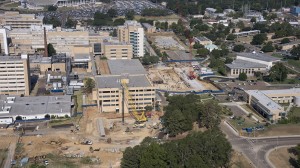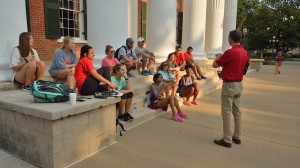OXFORD, Miss. – The end of each summer in Oxford is marked with an incredible resurgence of a vibrant and thriving community. This year is no exception.
Enrollment at the state’s flagship university expanded this fall for the 21st consecutive year, topping 23,800 students across all its campuses. This fall’s incoming freshman class also bucked a national trend by posting the highest ACT scores in Ole Miss history.
Preliminary data shows a total unduplicated enrollment of 23,838, largest in the state. That’s up 742 students from last fall, or 3.2 percent. The figures include the largest freshman class ever for any Mississippi university, a class that already sports impressive credentials of leadership and academic achievement.
“We are pleased that students and families continue to choose the University of Mississippi, recognizing the quality education and outstanding college experience we offer here,” Acting Chancellor Morris Stocks said. “Our faculty and staff work very hard to deliver the very best academic programs at a competitive price, and it’s rewarding to see those efforts acknowledged by a growing student body.”
The incoming freshman class increased to 3,969 students this fall, up 4.2 percent from last fall’s 3,809. The group posted an average ACT score of 24.7, besting last year’s average of 24.3 and setting a new UM record. Among Mississippi students, this year’s average was 24.4, up from last fall’s 24.0.
This positive trend has continued over the past eight years. Given the much-publicized stagnation in national ACT scores, this growth is particularly impressive, said Noel Wilkin, the university’s acting provost.
“We are attracting more students who are well-prepared to enter college,” Wilkin said. “At the same time, we are investing in programs to help students to be successful.”
The freshman class’ high school GPA increased too, growing from 3.49 to a school record 3.54 this fall.
This year’s first-time students include 94 class valedictorians, 56 salutatorians, 97 student body presidents, 126 Eagle Scouts and seven Girl Scouts who achieved the Gold Award, the organization’s highest youth honor.
“The University of Mississippi has a long history of attracting and developing student leaders,” Stocks said. “Our faculty, staff and alumni work together to provide a leadership training ground and to offer these young people valuable experiences. We look forward to seeing what this talented freshman class can accomplish during their time here and beyond.”
The university’s efforts to help new students adjust to college life and be successful also seem to be paying off. Student retention hit a new record, with 86.5 percent of last year’s freshmen returning to campus to continue their studies this fall.
“People around the state, nation and world are noticing the great things that are happening here at the University of Mississippi,” Wilkin said. “It is clear that students want to be a part of a vibrant and successful community of scholars, who provide them with incredible opportunities. The work that we do is filled with incredible purpose.”
The majority, 59.8 percent, of Ole Miss students are from Mississippi, including students from all the state’s 82 counties. The university also attracts students from around the nation and world. Overall, the student body includes representatives from 48 states, the District of Columbia and 90 foreign countries.
Minority enrollment totaled 5,511 students, or 23.1 percent. African-American enrollment is 3,194 students, or 13.4 percent of overall enrollment.
The university’s Sally McDonnell Barksdale Honors College continues to grow, enrolling 1,257 students this fall, more than doubling over the past 10 years. The acclaimed Honors College has a record 402 incoming freshmen, with 52 percent being Mississippi residents. This fall’s honors freshmen have an average ACT of 30.7 and an average high school GPA of 3.96. The first phase of a major expansion and renovation of the college’s facility is nearing completion on Sorority Row.
While many schools and programs experienced growth, the university’s accounting and journalism schools both enjoyed double-digit increases. Undergraduate enrollment in the Patterson School of Accountancy grew 18 percent and topped 1,000 for the first time, climbing to 1,135 students this fall, compared to 962 last year.
“One of the big reasons for this is the fact that our school has become a mainstay in the national rankings of accounting programs published by the Public Accounting Report,” said Mark Wilder, the school’s dean.
“The 2015 annual rankings were released in mid-August, and all three of our degree programs are among the top 8 nationally, and we are also the most highly ranked SEC school in the national rankings. Our programs have been ranked among the top 20 nationally for eight consecutive years, and we have been in the top 10 for each of the past five years.
“Our faculty play ‘the’ key role in our growth and our successes. They are devoted teachers and mentors to our students, they publish in the top accounting journals worldwide, and they are willing to work together toward our common goal and vision of having one of the nation’s top accounting program.”
In the Meek School of Journalism and New Media, undergraduate enrollment soared 26.6 percent, growing from 1,044 students in fall 2014 to 1,322 this year.
“We have a faculty of outstanding professionals who have intellectual depth, quality students from throughout the nation and an environment that places students first,” Dean Will Norton said. “In this ‘trophy generation,’ faculty who have taught at other universities tell me that our students have vision and drive. In brief, they are top caliber.”
Norton also credited Assistant Dean Charlie Mitchell for establishing “an effective system for recruiting students and finding ways to help them decide if the Meek School is a place where they would thrive.”

Several construction projects are under way to expand capacity at the University of Mississippi Medical Center.
Several programs at the university’s Medical Center experienced modest growth, including the schools of Medicine, Nursing and Dentistry. Lack of space has constrained growth on the health sciences campus for many years, but a new 151,000-square-foot School of Medicine building is taking shape there. The $74 million project is scheduled for completion in spring 2017. Other major projects at the Medical Center include an eight-level parking garage near the School of Dentistry, and a $45 million, 106,000-square-foot Translational Research Center, which is being built next to the Arthur C. Guyton Research Center.
To help accommodate the growing student population in Oxford, the university has opened a new residence hall in the Northgate area of campus, providing housing for 304 students. Two new five-story residence halls are under construction on the former site of Guess Hall, slated for completion next summer.
The university also recently opened a $15 million addition to Coulter Hall, home of the Department of Chemistry and Biochemistry, providing more than 35,000 square feet of new educational and research laboratory spaces, and a three-year project to expand and modernize the Student Union kicked off this summer.
For the coming year, university officials plan to begin work on a new recreation center and transportation hub, a $32 million project on the south end of campus; a $20 million renovation to Garland, Hedleston and Mayes halls, providing space for the School of Applied Sciences; and the university’s new science building, which will add 200,000 square feet of education and research space in the Science District for an estimated $135 million.
For more information on enrollment and programs at UM, go to http://www.olemiss.edu.
